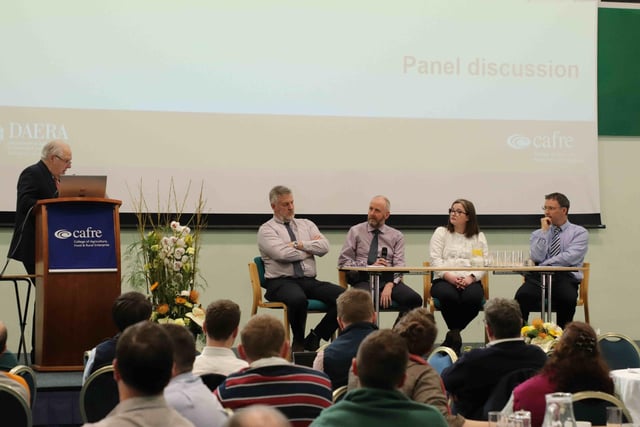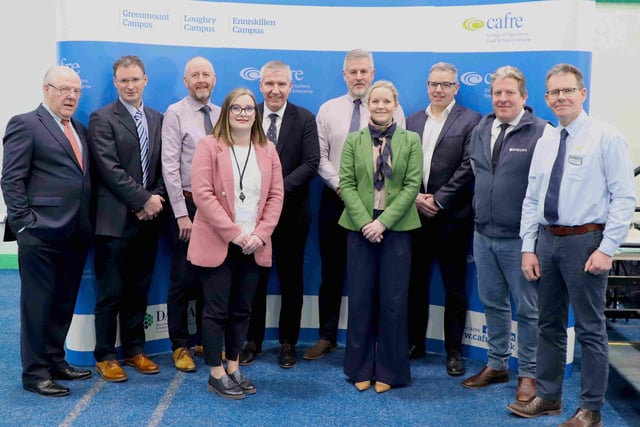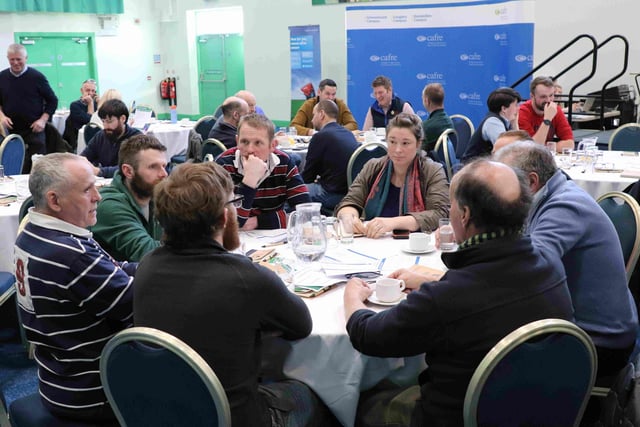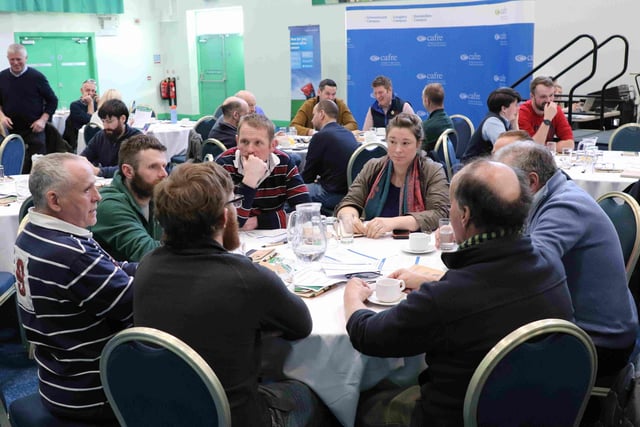The packed event at Greenmount was repeatedly given a common message by a range of speakers – there are a range of management approaches and technologies already available to reduce greenhouse gas (GHG) emissions towards meeting Net Zero targets without compromising food production.
“Misinformation and unfounded speculation, especially in social media has raised many concerns amongst farmers,” stated Don Morrow, Head of Dairying Branch at CAFRE.
“Fortunately the positive information provided here by speakers from DAERA policy and all parts of the supply chain, while acknowledging the scale of the challenge, has also identified pathways to a sustainable and profitable future based on achieving efficiency of production and adoption of new technologies.”
The morning session of the event, chaired by Don, kicked off with an outline of the relevant Climate Change regulation and policy by Claire Cockerall, Director of Green Growth and Climate Action Delivery, DAERA. Claire highlighted the ongoing development of Northern Ireland’s first Climate Action Plan and Carbon Budgets, and the UK Climate Change Committee view of a 21% reduction in emissions required by 2030.
Joe McDonald, Head of Corporate Affairs for the supermarket chain ASDA (NI), gave an informative talk on how Net Zero ambitions will be addressed by the retail trade. Farmgate emissions account for more than 50% of ASDA’s total carbon footprint, therefore working in partnership with primary producers will be vital to achieving success. This highlights the need for Carbon footprinting – the benchmarking of emissions at farm level – measuring, as the starting point to managing emissions. Detailed customer research and analysis by ASDA continually highlights that their customers seek “greener choices” at affordable prices. More worringly was the data presented that showed the NI consumer having the lowest household discretionary income of any region of the UK.
Ian Stevenson, chair of the Dairy Council (NI,) pointed out that producers have already reduced GHG emissions per kilogram of energy corrected milk by 37% in the period 1990 to 2020. During this time milk production has increased by 85% with only an 13% increase in dairy cow numbers. Efficiency of production has been, and will continue to be, the main driver. Ian also outlined how all stakeholders in the sector were coming together to develop and promote an industry wide approach to measuring and managing carbon emissions.
A final brief presentation from Oliver McEntyre , National Agricultural Startegy Director at Barclays considered what Carbon and wider environmental challenges might mean for funding of farm businesses. There already are more favourable interest rates and loan arrangements available for “green investments” and he indicated that further products will be launched by the banking sector. Farmers with considered plans to reduce emissions and address environmental challenges will be in a much better position to access finance in the future than those unwilling to adapt. A lively panel discussion where farmers questioned some of the underlying science and disproportionate focus on methane brought the morning session to a close before lunch.
The afternoon session was expertly managed by Mike Johnston, chair of the Carbon Farming Partnership’s Technical Working Group. Jim Uprichard of Trouw as Technical manager for Sustainability, NIGTA, related how the feed trade are adressing Carbon issues. Dairy cattle in the province consume 871,0000 tonnes of compound feed each year from a total of over 2.3 million tonnes. Clearly that tonnage of feed cannot be produced locally so the sector will continue to be reliant on imported feedstuffs. The carbon footprint of those raw materials varies greatly depending on the land use change associated with the area of origin. Efforts are being made to quantify and reduce that embedded footprint but feed efficiency will remain the central determinant of economic and financial sustainability.
The focus moved from reducing carbon intensity, ie emissions per kg of product, to reducing total emissions when Martin Mulholland of DAERA’s Carbon Reduction Policy Branch spoke. Ultimately net zero targets relate to emissions accounted for in the National Inventory. Martin outlined some of the key factors relating to feed, fertiliser and livestock that will need to be adopted in achieving carbon targets if a reduction in livestock numbers is to be avoided. Crtical to this will be the development and widespread use of feed additives to reduce enteric methane production.
The final presentation used the CAFRE dairy herd as a practical case study. Micheala Tener, Carbon Technologist at the college outlined the herd’s physical performance and carbon footprint, and showed how typical it was of farms across the province. The various mitigation and sequestration measures that could be implemented were then detailed by Alan Agnew, Senior Dairying Adviser. Alan showed that a combination of reducing replacement rate, replacing fertiliser with white clover on the grazing platform, using a methane inhibiting feed additive and increasing soil and biomass sequestration were all required to achieve a 21% reduction in net emissions on the dairy unit in the short term.
“Reducing emissions at farm level requires action on a lot of fronts but I hope we have shown that there are sound farming solutions to the challenge” said Alan. “I firmly believe this conference has shown that farmers who can adapt for greater efficiency, and adopt new technologies as they arise, will be able to produce low carbon milk by international standards and will have a bright future.”
In his close, Don Morrow thanked the auidence for their active participation in the event. He acknowledged that it was clear that there was an ongoing requirement to inform and update farmers on the science, the measurement and the methods of reducing GHG emissions and he idicated that this would be a key role for CAFRE going forward.
If you missed the event, you can view the presentations online at www.cafre.ac.uk//carbon-challenge


2. photo (8).jpg
Speakers and Chairs - L-R Mike Johnston (Carbon Farming Partnership’s Technical Working Group), Martin Mulholland Agric Policy, Jim Uprichard (NIGTA), Micaela Tener (CAFRE), Ian Johnston (NI Dairy Council), Alan Agnew (CAFRE), Claire Cockerill (Green Growth and Climate Change Delivery), Joe McDonnald (ASDA), Oliver McEntyre (Barclays), Don Morrow (CAFRE) Photo: DAERA

